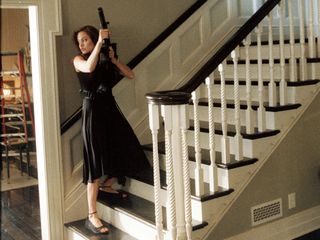‘My girlfriend was an assassin’
When photographer Jason P Howe fell in love with a beautiful woman he met during a work assignment, he had no idea she was leading a terrifying double life...

When photographer Jason P Howe fell in love with a beautiful woman he met during a work assignment, he had no idea she was leading a terrifying double life...
There comes a point in every new relationship when a girlfriend feels the time is right to share a secret – like how many sexual partners she’s had. So what happens when your new girlfriend has a much darker, more sinister secret than having slept around a bit?
Sitting naked on the edge of a bed in a sweltering hotel room in Colombia, I lit a cigarette and listened as a petite 22-year-old I’d known for a year and just made love to unleashed a secret dark enough to shake anyone from their post-coital bliss.
‘I’m an assassin, a trained killer,’ she said, holding my gaze with her soft, brown eyes. She tossed back a stray hair from her face and added, ‘I’ve killed over ten people with my bare hands.’ I put the cigarette to my lips and inhaled deeply. Marylin looked at me through exhaled smoke, waiting anxiously to see how I’d respond. Inside, I was simultaneously shocked, confused, and, if I’m honest, strangely thrilled.
I had been living in the heart of a war-torn, drug-producing region of southern Colombia on and off for a year, working as a freelance photographer. I’d just turned 30 and the trip had been made out of desperation. I’d grown up in a small town in Suffolk. I’d had a very ordinary working-class childhood and no encouragement from my family to travel, get a degree or do anything other than get a job that paid the bills. I left school at 16 to work in the camera section of Dixons, then went on to work for several years as a rep for a South American travel agency in West London. It wasn’t the best preparation for becoming a war photojournalist, but that’s what I’d always aspired to be. With my thirtieth birthday looming, I left London and headed to Colombia to throw myself in at the deep end. I couldn’t afford the fees for journalism school and was in need of an adventure.
I met Marylin on a local bus to Puerto-Asis, a major hub of drugs trafficking. For 40 years, Colombia had been plagued by violence. Two rival terrorist groups, United Self-Defense Forces of Colombia (AUC) and Revolutionary Armed Forces of Colombia (FARC), had pitched themselves against each other. Kidnapping, extortion, and illegal cocaine funded both armies and my goal was to photograph each group in their surroundings. Car bombs, assassinations, kidnappings, torture, massacre and forced disappearances were common. Life was cheap, but I wanted to be in the thick of things to learn my trade.
I first spotted Marylin in a queue for the bus I was catching to travel into the war-torn heartland. She smiled coyly at me. She was gorgeous and there was instant chemistry. Marylin was very chatty – flirty even – and I was struck by her petite figure and razor-sharp cheekbones. We sat side by side for the six-hour journey and she explained that she was returning from a clothes-buying trip in one of the big cities. She intended to resell the clothes to her friends and neighbours. She clearly had substance – so much more depth than the pampered, well-dressed beauty queens who inhabited the upmarket nightclubs of the capital.
Marie Claire Newsletter
Celebrity news, beauty, fashion advice, and fascinating features, delivered straight to your inbox!
When I mentioned my aim, she invited me to stay with her family on the outskirts of town. ‘My father runs a roadside bar where lots of soldiers from both sides hang out,’ she said. There was no hint of a relationship. Just an offer of friendship.

I spent the next few months living with Marylin and her family, using their home as a base while I made trips into the countryside to photograph the corn fields and death-squad personnel, returning every few weeks. My Spanish was limited and her English non-existent but, somehow, we communicated and managed to get on.
We spent long afternoons lying together in a hammock, holding hands, and kissed occasionally during walks to a local river. But it never went further. Marylin was a single mother to an adorable four-year-old daughter, Natalie, who we would take down to the river and watch as she splashed about in the water. Her previous partner, Natalie’s father, had died, and a relationship seemed inappropriate.
But things shifted between us one day a year after I had been there. I remember sitting drinking ice-cold beer with Marylin’s father while waiting for her to return from ‘errands’. When she did, my delight at seeing her overwhelmed me and, during a walk to the river, we fell into each other’s arms. That night, we decided to get a hotel room in town, so we could be together. Despite our different backgrounds, I felt a deep connection to her. I was in love.
We shared a bottle of red wine on the balcony and ate steak. Marylin stayed over that night and we slept together for the first time. There was so much pent up sexual energy that things were intense. It was so different to girls I’d met before. We were already good friends by the time we had sex and she was very adventurous and confident. It was the next morning that she decided to unload her secret.
Strangely, I didn’t recoil in horror at her confession. The months I had spent in Colombia, surrounded by violence, had altered my perspective. I was sleeping with a woman who kept her gun on my bedside table and set time aside to clean it.
Watching her take the pistol from her belt, unbutton her jeans and slip into bed, I somehow couldn’t equate the woman in my arms with the bodies I had seen in the local morgue, their heads shattered by gunshots and a close range. High on a combination of the heady tropical climate, local rum and lying in the arms of a nubile 22-year-old, fantasy and reality became blurred. It felt like I was living in a Quentin Tarantino movie.

A few weeks later, Marylin confessed she was a part of the right-wing death squad of AUC. Her job involved going by motorbike to shoot her ‘targets’ – FARC sympathizers – in the head, stab them with a knife or sometimes, inject them with a syringe full of air. Over the coming weeks, I plucked up the courage to ask her how she could live with herself.
‘When I killed the first person, I was afraid,’ she confessed. ‘The person I killed was kneeling down, begging not to die and crying, “Don’t do it, I have children.” I only killed so as not to be killed myself by the head of my group. After a killing, you keep trembling. You can’t eat or talk to anyone. I was at home, but I kept imagining the person begging for their life.’
She said the second time was only slightly easier but, with time, she had lost the fear and began commanding money as a professional killer, taking on everything from AUC jobs to family disputes. Then, one day over dinner, she confessed, ‘I’ve killed 23 people. Now I’m still killing and nothing happens. I feel normal. I get paid per job in cash. It doesn’t matter what the problem is. They pay me and tell me to kill and that’s what I do. But it’s painful for me to see the family of my victims – to see a man’s mother crying, knowing I am the one guilty of having caused the death.’
Within weeks of learning what she did, my mind was in turmoil over my relationship with Marylin. One morning, over eggs on toast, she told me that the previous night she had been persuaded by a friend to decapitate and dismember another woman. The victim was not an informer. She was just someone who had been sleeping with the friend’s boyfriend. Marylin described so graphically what had happened, with so little feeling that, at last, reality kicked in. I found my feelings about her changing and madly accelerating towards a point of no return. I remember a terrible sadness washing over me as I sat and looked at the intelligent, attractive woman in front of me. She represented everything that was wrong with the country. The boredom, greed, lack of prospects and a desensitisation to the suffering of others. It was tragic.
I was still desperately attracted to her sexually, but the semi-heroic light that I had been viewing her in was fading fast. She was, in effect, a freelance killer, taking life for money, which she blew on clothes and make-up. Had her ‘profession’ not been independently confirmed by a trustworthy local source, I might have been able to write off her story as the creation of a bored, imaginative young woman living in the modern-day equivalent of the Wild West. But this was real.

We began regularly rowing about what she did, with me trying to persuade her to give it up. One afternoon, in the heat of an argument, she pointed a gun at my head. ‘Why aren’t you scared of me?’ she screamed. It was a wake-up call. I left Colombia in shock the next day.
Over the course of the following year, as I travelled the world in my role as a photojournalist, Marylin and I periodically exchanged emails. They mainly involved her telling me she wanted to make a new start, but that the AUC would not let its members leave alive.
After a long period of silence, I began to fear something had happened, and so I returned to Puerto Asis to learn the truth. It took me some time to pluck up the courage to drive out to Marylin’s home on the outskirts of town to see if she and her family were still around.
All my fears were confirmed when her tearful father told me that Marylin was dead. She was 25 years and two months old when they took her from her family’s home and stoned her to death. They crushed her head with rocks and then shot her. As he uttered the words, I felt my eyes welling up, too. I was speechless. The shock literally took my breath away.
I went into the house to see her brother, who was lying in his bedroom staring into space. He had been forced to identify her broken body and, ever since, he had bed-bound with trauma-induced paralysis, unable to speak, walk or move. The effect of this tragedy was almost worse than the loss of the woman I’d loved.
Marylin was not killed by some local seeking revenge for one of the many deaths she had carried out during her time as an assassin. She was murdered by her own group as a symbolic stoning for being an informer. Her most recent boyfriend was a government soldier. It had been enough to get her killed when that relationship soured and her idle pillow talk continued.

I sat down outside her house, my head in my hands, and remembered the conversations we had about changing her life and the emails I received from her saying she needed to get out of the mess she was in. I remembered what it was like to kiss her in those days before I found out she was a killer. I was sad, but I knew she had caused this same pain to others.
The next morning, I visited her tomb with Marylin’s mother and her daughter, Natalie, who were both in their best dresses and carried flowers. Then, later that day, I discovered over dinner with a well-informed local that Marylin had been an assassin a lot longer than she had admitted to me. It was widely known that she was involved in the massacre of 26 villagers, many of whom were decapitated and disembowelled before being thrown into a river. I felt so physically sick that I couldn’t eat my meal. I bolted back to my hotel and booked a seat on the next available flight. As the plane took off, I felt an immense relief wash over me.
It’s now four and a half years since I learned of Marylin’s death. I am still photographing wars and have witnessed and felt much more pain and grief since that day. But as time goes on, it had become easier for me to understand how she and others become entangled in such dreadful situations. I have learned to become less judgemental of the choices people make, even when they seem to be in the wrong. I haven’t had many serious relationships since Marylin, which is partly down to being attracted to exciting women with fascinating lives. In fact, I must confess, if I had a chance to replay my life, I can’t be sure that I wouldn’t fall for that magnetic brunette at the bus stop all over again.
Colombia: Between the Lines (£20, ConflictPics) by Jason P Howe is available from Amazon and conflictpics.com
The leading destination for fashion, beauty, shopping and finger-on-the-pulse views on the latest issues. Marie Claire's travel content helps you delight in discovering new destinations around the globe, offering a unique – and sometimes unchartered – travel experience. From new hotel openings to the destinations tipped to take over our travel calendars, this iconic name has it covered.
-
 Zendaya's reaction to awkward kissing question during Challengers interview has gone viral
Zendaya's reaction to awkward kissing question during Challengers interview has gone viral'Uncomfortable' doesn't begin to cover it
By Iris Goldsztajn
-
 Prince William feels 'immense responsibility' amid Kate and Charles cancer diagnoses
Prince William feels 'immense responsibility' amid Kate and Charles cancer diagnosesHe has a lot on his plate
By Iris Goldsztajn
-
 Taylor Swift just teased a 'timetable' for her new album release
Taylor Swift just teased a 'timetable' for her new album releaseThe wait is torture
By Iris Goldsztajn